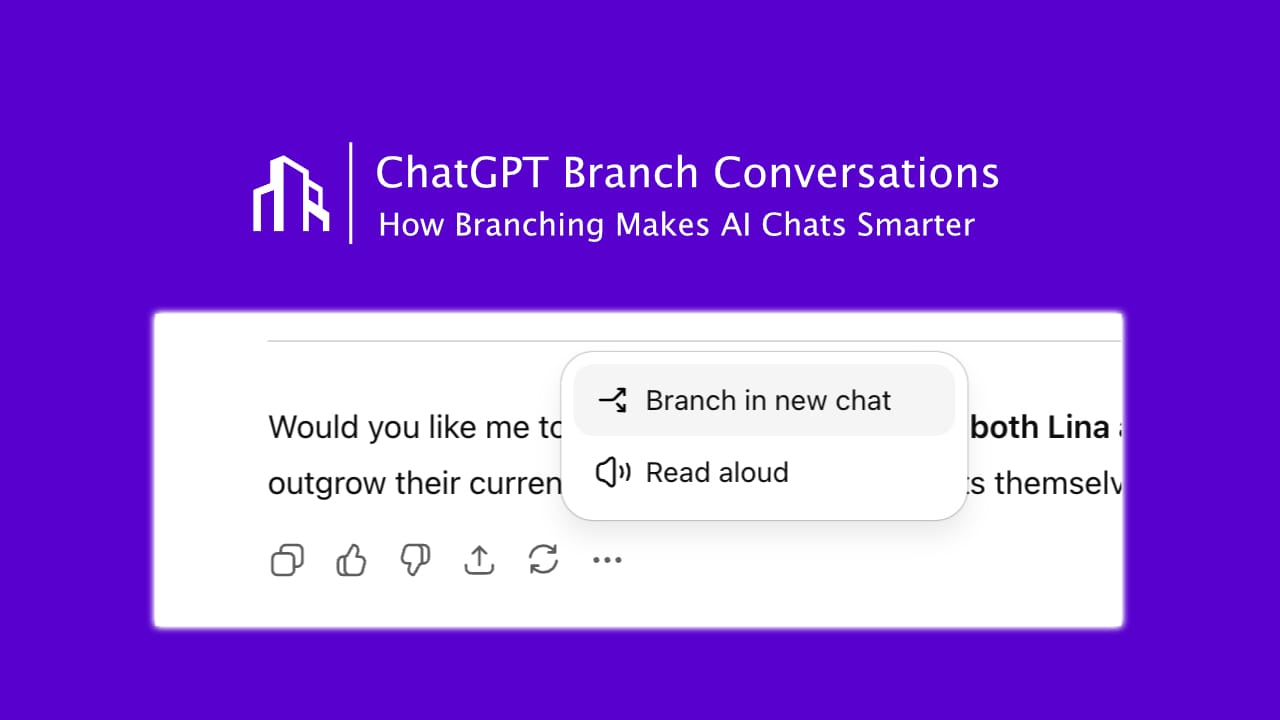ChatGPT Branch Conversations: How Branching Makes AI Chats Smarter

OpenAI has introduced one of the most requested features in ChatGPT: Branch Conversations.
This new capability that was first requested in early January 2025, lets you “fork” a conversation into a new thread without losing the original context. In practice, it transforms ChatGPT from a linear chat log into a multi-path exploration engine.
For anyone working in business strategy, product design, research, or automation, branching is more than a UI upgrade it’s a shift in how you collaborate with AI.
ChatGPT Branch Example Video
The Problem With Linear AI Chats
Until now, ChatGPT worked like a single conversation lane. If you wanted to try a new direction, you had two options:
- Rewrite the prompt and overwrite your context.
- Start a fresh chat and lose valuable history.
Both options wasted time and made it harder to compare results side by side. Imagine running five different sales copy drafts or testing three different data models you either had to juggle multiple tabs or keep scrolling up and down in one chat.
How Branch Conversations Work
The process is refreshingly simple:
- Hover over a message in ChatGPT.
- Choose “Branch in new chat”.
- A new thread opens, carrying all context up to that point.
- Continue your exploration without changing the original path.
This means you can now spin off parallel versions of the same conversation. Think of it as cloning a project file in design tools like Figma or forking a repo in GitHub.

Also See: Branching Conversation Examples
Key Benefits of Branching
Branch Conversations bring a set of advantages that map directly to business use cases:
1. Parallel Exploration
No more “what if I try this instead?” regrets. Branching lets you explore multiple options in real time.
2. Context Preservation
Every branch inherits the conversation state at the split point, ensuring continuity.
3. Comparison at Scale
Branches make it easier to evaluate outcomes side by side critical for teams making data-driven decisions.
4. Documentation and Compliance
By saving each branch, you create a transparent decision trail, useful for compliance and audits.
Example Scenarios
Marketing Teams
- Draft three ad campaigns with different tones.
- Branch into variations for specific customer segments.
- Compare CTR predictions side by side.
Product Development
- Prototype different user onboarding flows.
- Branch for “minimal steps,” “gamified experience,” and “enterprise onboarding.”
- Select the best fit based on user testing.
Data Science
- Run parallel model prompts for feature engineering.
- Explore hyperparameters in separate branches.
- Document results in one consolidated view.
Customer Support
- Train AI assistants with alternative escalation flows.
- Compare effectiveness across branches.
- Standardize the best responses.
Business Impact
Branching is especially powerful for SMEs and scale-ups that need agility:
- Faster decision-making: Parallel idea testing saves hours of iteration.
- Reduced costs: Less duplication of work across teams.
- Higher creativity: Teams can take risks without fear of losing progress.
- Better governance: Decision trees remain auditable and reviewable.
It also fits naturally into AI workflow automation, where branching becomes a blueprint for multi-path process design. Businesses can build scalable playbooks where each branch represents a strategic option.
Risks and Considerations
Like any powerful feature, branching should be used thoughtfully:
- Branch overload: Too many forks can create noise. Discipline in naming and managing branches is key.
- Decision fatigue: Teams may overanalyze instead of converging on a decision.
- Privacy: Branches retain original context, so be mindful of sensitive data before sharing.
Handled well, though, the risks are minimal compared to the productivity upside.
A New Way to Think About AI Collaboration
Branch Conversations signal a broader trend: AI tools are evolving from single-thread assistants into collaborative workspaces. Just like version control revolutionized software development, branching could redefine how knowledge workers engage with AI.
Instead of thinking linearly, we can now think in decision trees, experiments, and playbooks. That aligns perfectly with the realities of modern businesses, where agility and iteration are non-negotiable.
Final Verdict
Branch Conversations are more than a convenience. They are a structural upgrade that positions ChatGPT as a true idea management system.
From startups to enterprises, the ability to branch, test, and compare gives teams a new layer of productivity.
Expect branching to become a core part of strategy sessions, prototyping, content development, and automation workflows.
Want to Explore Branching for Your Business?
At Scalevise, we help SMEs and scale-ups implement AI tools that drive real ROI.
From automation pipelines to AI-powered agents, we design systems that use ChatGPT (and its new branching features) to accelerate growth. Schedule a call with us.
